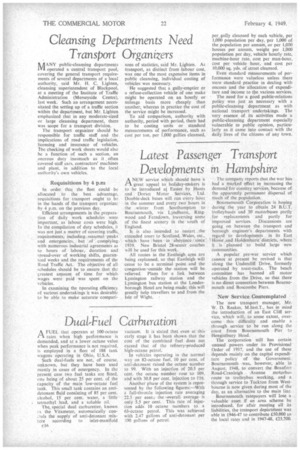Cleansing Departments Need
Page 22

If you've noticed an error in this article please click here to report it so we can fix it.
Transport Organizers NAANY public-cleansing departments 01 operated a central transport pool, covering the general transport requirements of several departments of a local authority; said Mr. H. C. Lighten, cleansing superintendent of Blackpool, at a meeting of the Institute of Traffic Administration (Merseyside Centre), last week. Such an arrangement necessitated the setting up of a traffic section within the department, but Mr. Lighten emphasized that in any moderate-sized or large cleansing department, there was scope for a transport division.
The transport organizer should be responsible for traffic staff andthe implications of road traffic legislation, licensing and insurance of vehicles. 'the checking of work sheets would also he a function of such a section, an onerous duty inasmuch as it often covered staff cars, contractors' machines and plant, in addition to the local authority's own vehicles.
Requisitions by 4 p.m
In order that the fleet could be allocated to the best advantage, requisitions for transport ought to be in the hands of the transport organizer by 4 p.m. on the previous day.
Efficient arrangements in the preparation of daily work schedules were important, as labour costs were high. In the compilation of duty schedules, it was not just a matter of covering traffic, requirements, including seasonal -peaks and emergencies, but of complying with numerous industrial agreements as to hours of labour, duration and spread-over of working shifts, guaranteed weeks and the requirements of the Road Traffic Act. The objective of all schedules should be to ensure that the greatest amount of time for which wages were paid was spent on the vehicles.
In examining the bperating efficiency of various undertakings it was desirable to be able to make accurate compari sons of statistics, said Mr. Lighten. As transport, as distinct from labour cost, was one of the most expensive items in public cleansing, individual costing of vehicles was necessary.
He suggested that a gully-emptier or a refuse-collection vehicle of one make might be operated on an hourly or mileage basis more cheaply than another, whereas in practice the cost of the service might be increased.
To aid comparison, authority with authority, period with period, there had to be costing units or standard measurements of performance, such as cost per ton, per 1,000 gullies cleansed, per gully cleansed by each vehicle, per 1,000 population per day, per 1,000 of the population per annum, or per 1,000 houses per annum, weight per 1,000 population per day, vehicle hourly rate, machine-hour ratc, cost per man-hour, cost per vehicle hour, and cost per 10,000 sq. yds. of street cleansed.
Even standard measurements of performance were valueless unless there were standard practice in dealing with oncosts and the allocation of expenditure and income to the various services. The need for a good public-relations policy was just as necessary with a public-cleansing department as with national transport undertakings. The very essence of its activities made a public-cleansing department especially vulnerable to public opinion, particularly as it came into contact with the daily lives of the citizens of any town.


























